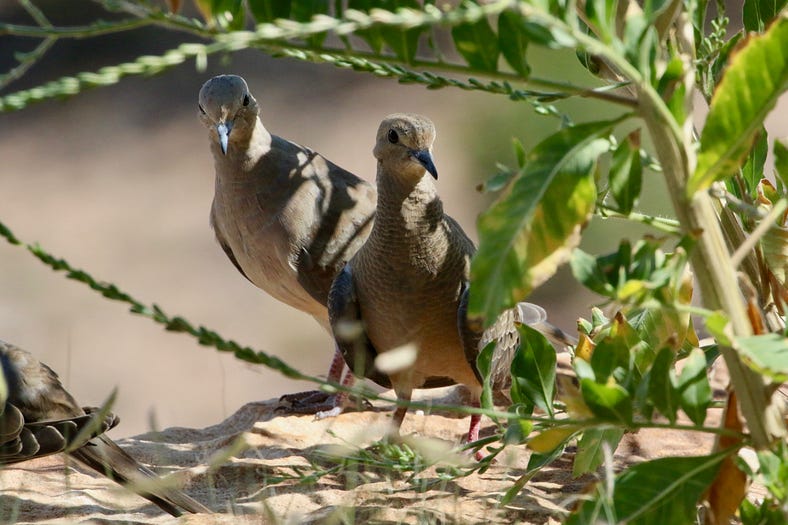Freighted Meaning and Hunting Targets

A pair of mourning doves eat the seeds underneath my feeder. Although I rotate the bird feeder on a pole, the squirrels’ acrobatics get the seeds to fall. It serves them, but also the birds who prefer pecking from the dirt to darting from a tree branch to the feeder’s perch. I watch the chickadees and finches dart.
The mourning doves are teaching me new lessons.
They are always together. They will even bob their heads in synchony. Doves are spiritual symbols for so much — but they don’t know the freighted weight they carry on their feathered shoulders of our totemic expectations.
I am touched by how devoted they are to each other.
I know doves are released at weddings and are symbols of love and devotion. But I haven’t observed their daily life before. My patio faces a hedgerow of different bushes and vines, and then some tall pines and cedars are nearby. The varied habitat means I observe a variety of birds and small animal life.
Two married professors of mine, years ago, shared an office. Their desks were moved together, facing each other. I found that sort of togetherness — seeing your spouse whenever you looked up from your work — unfathomable. Independent me found that amount of interdependence quaint, a remnant of the past. It was almost as bad as those couples who dress in matching shirts or are always color coordinated. Ugh.
Until the mourning doves. In their species, I find the togetherness moving. Touching.
Other birds visit the feeder as singletons, darting in and out. A spotted towhee is also a ground feeder, but he visits alone. His mate follows at a different time.
The squirrels might visit as a family, but there seems to be a hierarchy of who gets closest to eat the prime sunflower seeds first. The pocket gopher only visited once or twice in spring. I understand she (or he) tends the roots of plants in the underground tunnels created in the bank up past the hedgerow, much like a farmer tends crops.
Mourning doves are named for their mournful cooing that graces the morning air. It may only sound mournful to our human ears; perhaps it is love language to the other dove. They must nest nearby, though I saw no fledglings this season.
Mourning doves are widely hunted. Their species is present all over the United States, so they are not threatened.
I wonder if this distinguishes our politics — the doves that symbolize peace, or love, or commitment, or the target practice smallish doves provide to upland game bird hunters. The meat of the doves is so small as to seem not worth the work of cleaning and cooking. But the fact they are ubiquitous and challenging to hit probably makes good shooting practice before going for grouse and ducks and other desirable birds in their seasons.
Many game hunters are great conservationists of habitat. They appreciate the inter-relationships of wild things.
Meanwhile, the pair outside my window are oblivious to the weight of spiritual symbolism or the caution birds need when hunters stalk their habitat. They don’t care about the politics of environmentalism or the arguments of humans.
They are a family of suburban birds, living a quiet, backyard life.
Like me, in retirement.

SingingFrogPress
Oh I like this essay. I’ve loved watching doves when they came to eat beneath our bird feeders, and when they’ve nested in nearby trees.
Vicki
Such a sweet, well-written description of the life outside your window. I loved this:)